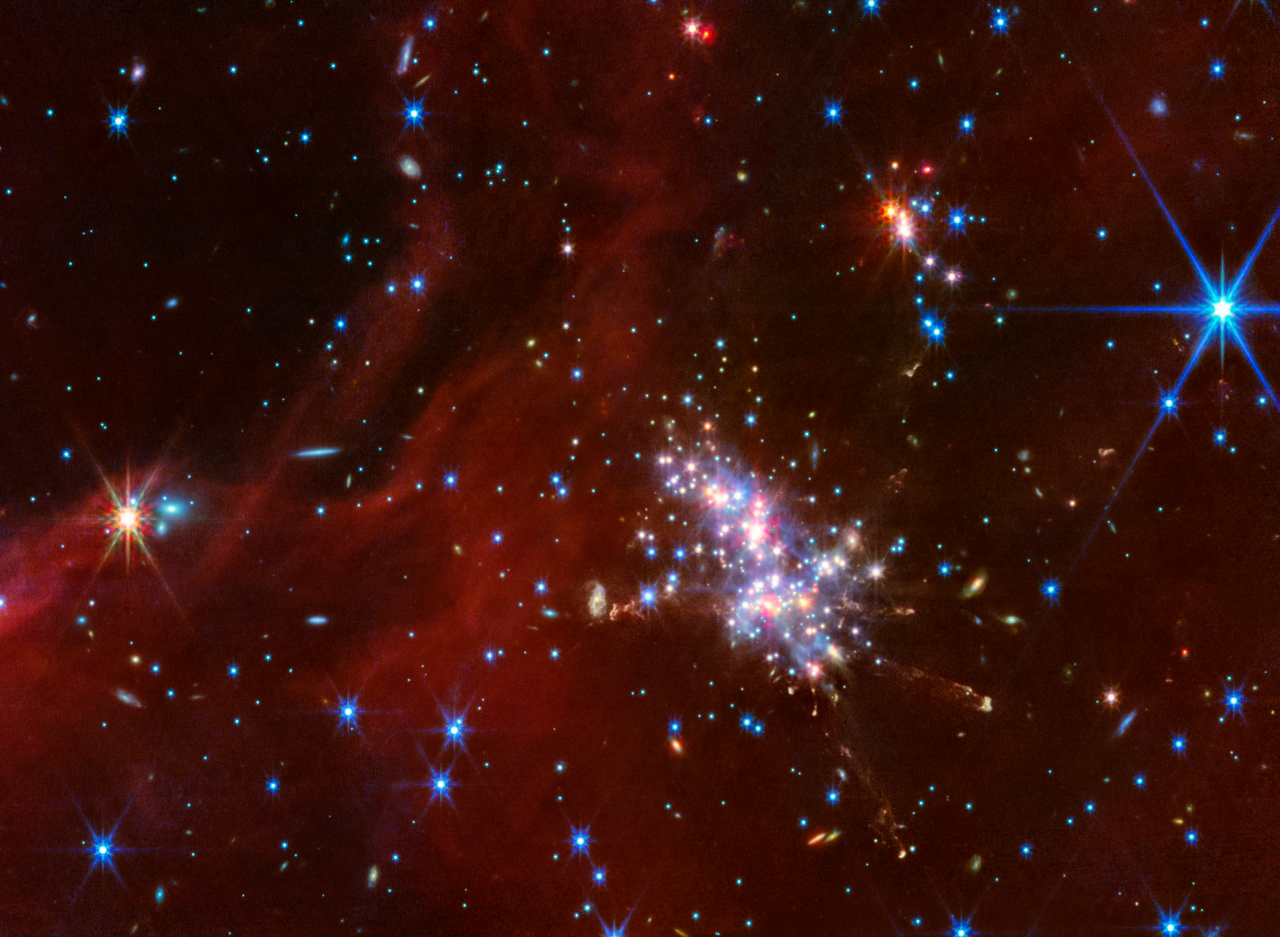Reviewed by Danielle Ellis, B.Sc.Sep 13 2024
According to the Astronomical Journal, a team of scientists utilized Webb's NIRCam (Near-Infrared Camera) and MIRI (Mid-Infrared Instrument) to examine specific portions of two molecular clouds known as Digel Clouds 1 and 2.
 Scientists used NASA’s James Webb Space Telescope to examine select star-forming areas in the Extreme Outer Galaxy in near- and mid-infrared light. Within this star-forming region, known as Digel Cloud 2S, the telescope observed young, newly formed stars and their extended jets of material. This Webb image also shows a dense sea of background galaxies and red nebulous structures within the region. In this image, colors were assigned to different filters from Webb’s MIRI and NIRCam: red (F1280W, F770W, F444W), green (F356W, F200W), and blue (F150W; F115W). NASA, ESA, CSA, STScI, M. Ressler (JPL). Image Credit: NASA
Scientists used NASA’s James Webb Space Telescope to examine select star-forming areas in the Extreme Outer Galaxy in near- and mid-infrared light. Within this star-forming region, known as Digel Cloud 2S, the telescope observed young, newly formed stars and their extended jets of material. This Webb image also shows a dense sea of background galaxies and red nebulous structures within the region. In this image, colors were assigned to different filters from Webb’s MIRI and NIRCam: red (F1280W, F770W, F444W), green (F356W, F200W), and blue (F150W; F115W). NASA, ESA, CSA, STScI, M. Ressler (JPL). Image Credit: NASA
Astronomers have instructed NASA's James Webb Space Telescope to investigate the edges of the Milky Way galaxy. Scientists refer to this region as the Extreme Outer Galaxy since it is more than 58,000 light-years from the Galactic Center. (For reference, Earth is around 26,000 light-years from the center.)
With its great sensitivity and precise resolution, the Webb data revealed unparalleled detail about these locations, which are home to star clusters undergoing bursts of star formation. This data contains information about cluster components, including extremely young (Class 0) protostars, outflows and jets, and different nebular structures.
These Webb observations, made with telescope time allotted to Mike Ressler of NASA's Jet Propulsion Laboratory in Southern California, allow scientists to study star formation in the outer Milky Way with the same level of detail as they do in their own solar neighborhood.
In the past, we knew about these star forming regions but were not able to delve into their properties. The Webb data builds upon what we have incrementally gathered over the years from prior observations with different telescopes and observatories. We can get very powerful and impressive images of these clouds with Webb. In the case of Digel Cloud 2, I did not expect to see such active star formation and spectacular jets.
Natsuko Izumi, Study Lead Author, National Astronomical Observatory of Japan, Gifu University
Stars in the Making
Despite being part of the Milky Way, the Digel Clouds contain few elements heavier than hydrogen and helium. Their structure makes them similar to dwarf galaxies and the Milky Way in its early stages. As a result, the researchers took use of Webb's ability to catch activity in four clusters of young stars within Digel Clouds 1 and 2: 1A, 1B, 2N, and 2S.
Webb recorded the main cluster of Cloud 2S, which contains young, newly created stars. This dense region is quite active, as multiple stars produce lengthy jets of material around their poles. Additionally, while scientists have previously speculated the presence of a sub-cluster within the cloud, Webb's imaging capabilities proved its existence for the first time.
We know from studying other nearby star-forming regions that as stars form during their early life phase, they start emitting jets of material at their poles. What was fascinating and astounding to me from the Webb data is that multiple jets are shooting out in all different directions from this cluster of stars. It’s a little bit like a firecracker, where you see things shooting this way and that.
Mike Ressler, Study Second Author and Principal Investigator, Gifu University
The Saga of Stars
The Webb imagery skims the surface of the Extreme Outer Galaxy and the Digel Clouds, and it is only the beginning for the team. They want to return to this Milky Way outpost to investigate a variety of current mysteries, including the relative abundance of stars of different masses inside Extreme Outer Galaxy stellar clusters. This measurement can assist astronomers in understanding how a certain environment influences various types of stars throughout their development.
Izumi added. “I’m interested in continuing to study how star formation is occurring in these regions. By combining data from different observatories and telescopes, we can examine each stage in the evolution process. We also plan to investigate circumstellar disks within the Extreme Outer Galaxy. We still don’t know why their lifetimes are shorter than in star-forming regions much closer to us. And of course, I’d like to understand the kinematics of the jets we detected in Cloud 2S.”
Though the process of star creation is complicated, and certain chapters remain a mystery, Webb is gathering evidence and assisting scientists in unraveling this fascinating saga.
The observations were conducted as part of the Guaranteed Time Observation Program 1237.
Journal Reference:
Izumi, N., et al. (2024) Overview Results of JWST Observations of Star-forming Clusters in the Extreme Outer Galaxy. The Astronomical Journal. doi:10.3847/1538-3881/ad4e2e